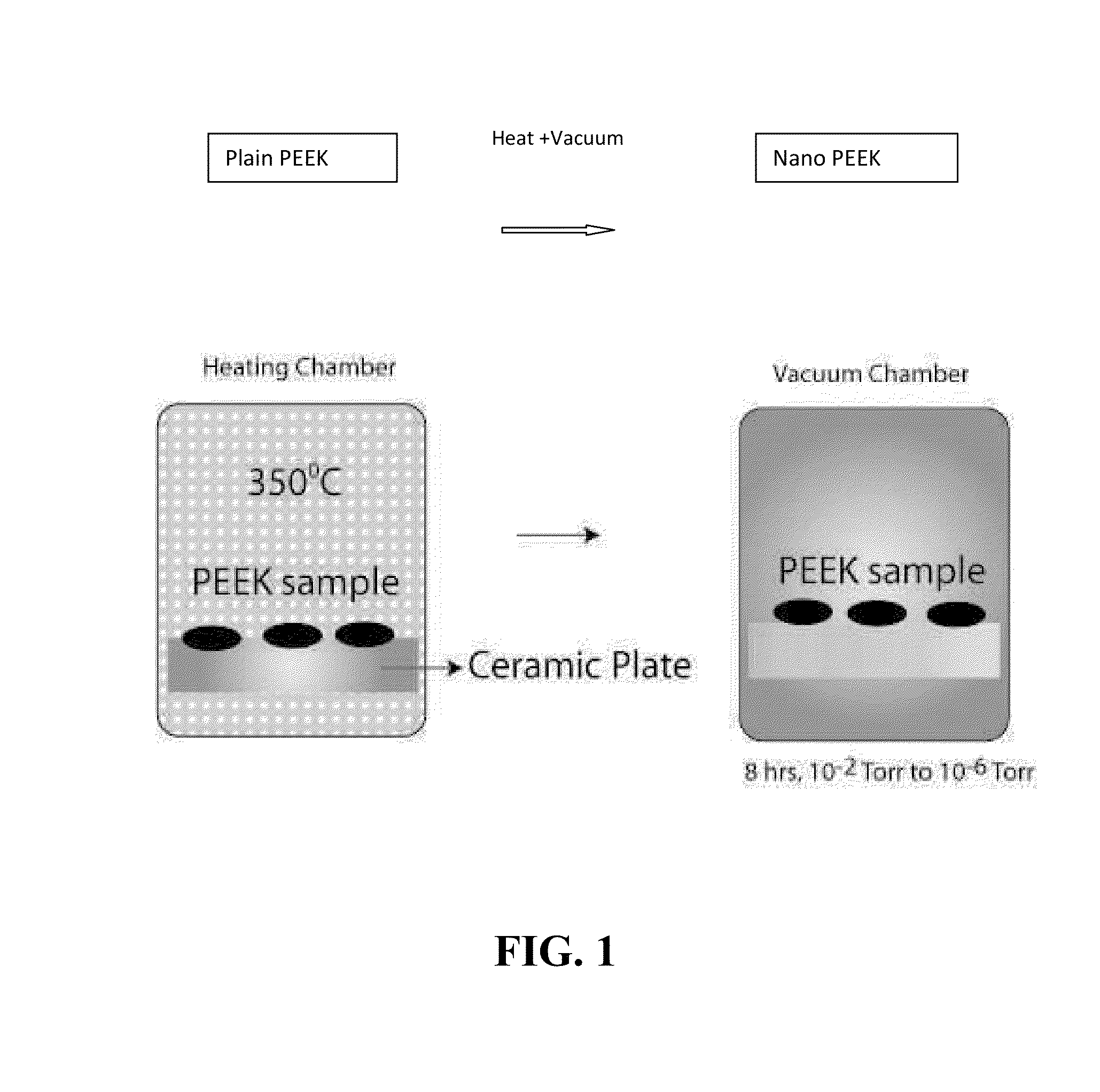Method for producing nanosurfaces with nano, micron, and/or submicron structures on a polymer
a polymer and nano-scale technology, applied in the field of modified polymeric materials, can solve the problems of nano-scale roughness, delamination of polymer or added material, wear debris formation, and current methods for creating surface roughness (e.g., at the submicron and micron level), and achieve the effect of reducing particle debris and efficient mass production
- Summary
- Abstract
- Description
- Claims
- Application Information
AI Technical Summary
Benefits of technology
Problems solved by technology
Method used
Image
Examples
example 1
Nano PEEK Spine Cages
[0080]As provided by the present invention, research and testing has produced a nano surfaced PEEK without any chemical treatment, but using high vacuum (in the range of 10−2 Torr to 10−6 Torr) and a temperature of 350° C. at 15 min, 30 min, 60 min. The surface is novel and the processing method is novel.
[0081]FIG. 1 is a schematic of one embodiment of the nano PEEK preparation method of the present invention. For example, PEEK coupons were kept in the pre-heated (at 350° C.) heating oven for 15, 30, 60 min, respectively. Ceramic plates were used to keep the coupons. After the above prescribed times, the samples were immediately transferred to a vacuum chamber and high vacuum was applied for 8 hours. Vacuum was released slowly and the PEEK samples were characterized further. SEM analysis (see FIGS. 2-3) and contact angle analysis experiments were performed and confirmed the nano features on the modified surfaces and changed contact angle values. Initial in vitro...
example 2
Nano Polypropylene Hernia Mesh
[0083]As provided by the present invention, research and testing has produced two different novel nano surfaced polypropylene based hernia mesh scaffolds without any harsh chemicals (acids and bases). For example, one approach used mild, easily removable methylene chloride in combination with high vacuum (in the range of 10−2 Torr to 10−6 Torr). Additionally, a second nanorough surface was produced on the polymer scaffolds at the same high vacuum condition using a temperature of 60° C. without any chemical treatment. Both surfaces are novel and the processing methods are novel.
[0084]The surface of the polymer scaffold is processed at high vacuum (typically around at 10−6 Torr) with pre-set mild heat (at 60° C.) or with methylene chloride treatment without heat treatment for 24 hours (see FIG. 6). For the treated samples, polymer scaffolds were gradually brought down to atmospheric pressure and temperature.
[0085]To look for the surface difference between...
example 3
Calcium Deposition Results Using Osteoblast Cells
[0089]Calcium deposition studies with osteoblast cells were conducted for various embodiments of the process of preparing modified polymeric materials having micron and submicron surface roughness. In particular, calcium deposition studies were conducted using PEEK nanosurfaced using (i) a sulfuric acid etching technique (PEEK 1) and (ii) a heat plus high vacuum technique (PEEK 2), as described herein.
[0090]FIG. 8 illustrates the calcium deposition / osteoblast cell results PEEK (untreated), nanoPEEK 1 (H2SO4 treated), nanoPEEK 2 (heated at 350° C. for 1 hour, followed by vacuum), and glass after 1 w, 2 w, and 3 w.
[0091]Increased osteoblast adhesion correlates to enhanced cell-to-cell contact which can promote osteoblast differentiation to calcium depositing cells. Compared to untreated PEEK, this study provided evidence of enhanced Ca deposition on both treated PEEK after 3 weeks. While Ca deposition by both treated PEEK was not differ...
PUM
| Property | Measurement | Unit |
|---|---|---|
| temperature | aaaaa | aaaaa |
| temperature | aaaaa | aaaaa |
| temperature | aaaaa | aaaaa |
Abstract
Description
Claims
Application Information
 Login to View More
Login to View More - R&D
- Intellectual Property
- Life Sciences
- Materials
- Tech Scout
- Unparalleled Data Quality
- Higher Quality Content
- 60% Fewer Hallucinations
Browse by: Latest US Patents, China's latest patents, Technical Efficacy Thesaurus, Application Domain, Technology Topic, Popular Technical Reports.
© 2025 PatSnap. All rights reserved.Legal|Privacy policy|Modern Slavery Act Transparency Statement|Sitemap|About US| Contact US: help@patsnap.com



